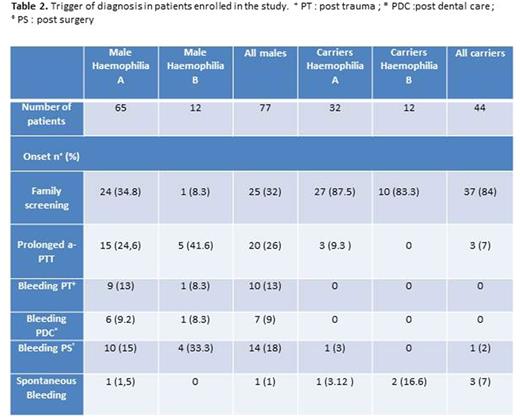Abstract
Introduction
Because of the recessive X-linked inheritance pattern of haemophilia, men are mainly affected while women are more commonly heterozygote carriers of the disease. Carriers of haemophilia may exhibit an increased bleeding tendency depending on to their clotting factors. However female haemophilia as a disease entity has so far received much less attention than haemophilia in males. In this study we compared the clotting factor levels, clinical presentation and treatment modalities among carriers with clotting factor deficiency referred as female haemophilia patients and mild male haemophilia patients.
Methods
All male patients with mild HA or HB and identified haemophilia carriers with a clotting factor deficiency in the mild range (FVIII or FIX levels 0.05-0.5 IU/mL) regularly followed at the Cliniques universitaires Saint-Luc, Brussels were enrolled in the study. The following parameters were recorded: basal level of the deficient factor, age, trigger for diagnosis, age at diagnosis, bleeding phenotype, response to desmopressin (DDAVP). Hemorrhagic phenotype was evaluated taking in consideration 12 different typical bleeding symptoms.
Results
44 carriers (32 carrying HA and 12 HB) and 77 male patients (55 with HA and 12 with HB) were identified compared. Carriers had significantly higher clotting factors levels than male patients (0.33 IU/ml vs. 0.20 IU/ml, p<0.0001). The mean age at diagnosis was lower male patients compared to carriers (19.18 (range 1-77) versus 31.63 years (range 2-83) (p=0.0052), respectively). The main trigger for diagnosis in carriers was family screening in relatives of probands (84%). A minority of carriers with clotting factor deficiency were diagnosed after bleeding complications, mostly surgical procedures and for work-up of aPTT prolongation (Table 1). By contrast, in male patients the most frequent reason of diagnosis was the onset of bleedings complications (42%), mainly following trauma or surgical/invasive procedures. As regards the gender-linked hemorrhagic manifestations in our cohort of carriers,
menorrhagia was the most frequent symptom (64%) and postpartum hemorrhages was reported in 34% of pregnancies. When these two feminine items were removed from the comparison, the most prevalent bleeding symptoms in both male and female patients were as follows: mucocutaneous bleeding (81% men vs 77% women), bleeding post medical interventions (69% vs 50%) and hematoma (68% vs 34%). Joint bleeds were reported by only 4% of carriers and by 36% of male patients. DDAVP test infusion was performed in the majority of male patients with HA (75%) with an overall response rate (ORR) of 92% (73% CR and 18% PR). In the group of carriers the test was performed in 66% with ORR of 95% (90% CR and 5%PR).
Conclusions
Carriers of haemophilia with clotting factor deficiency referred to as female haemophilia patients represent one third (36%; 44/121) of the whole population with mild haemophilia. Even if female patients are diagnosed later than male patients and the main trigger for the diagnosis was the family screening rather than bleeding symptoms, we found a comparable bleeding phenotype, characterized by mucocutaneous and post injuries bleeding complications. Menstruations and pregnancy represent an intrinsic hemostatic challenge and influence the management of female carriers. Carriers with clotting factor levels in the range of mild haemophilia represent a significant group of patients and should be considered and managed as female haemophilia patients requiring appropriate management and associated with specific challenges that deserve more research.
No relevant conflicts of interest to declare.
Author notes
Asterisk with author names denotes non-ASH members.


